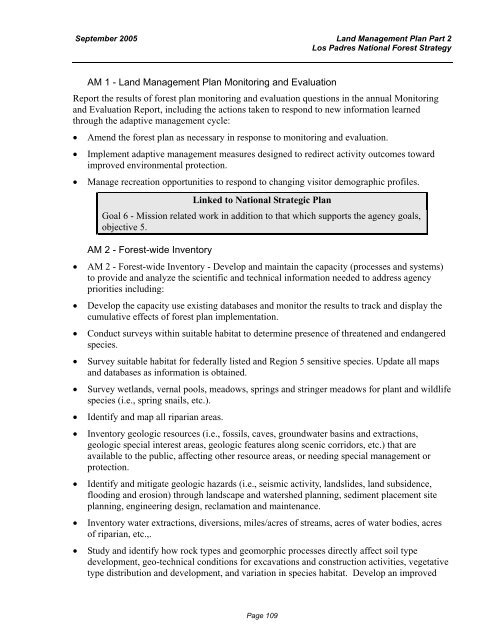Land Management Plan - Part 2 Los Padres National Forest Strategy
Land Management Plan - Part 2 Los Padres National Forest Strategy
Land Management Plan - Part 2 Los Padres National Forest Strategy
Create successful ePaper yourself
Turn your PDF publications into a flip-book with our unique Google optimized e-Paper software.
September 2005 <strong>Land</strong> <strong>Management</strong> <strong>Plan</strong> <strong>Part</strong> 2<br />
<strong>Los</strong> <strong>Padres</strong> <strong>National</strong> <strong>Forest</strong> <strong>Strategy</strong><br />
AM 1 - <strong>Land</strong> <strong>Management</strong> <strong>Plan</strong> Monitoring and Evaluation<br />
Report the results of forest plan monitoring and evaluation questions in the annual Monitoring<br />
and Evaluation Report, including the actions taken to respond to new information learned<br />
through the adaptive management cycle:<br />
• Amend the forest plan as necessary in response to monitoring and evaluation.<br />
• Implement adaptive management measures designed to redirect activity outcomes toward<br />
improved environmental protection.<br />
• Manage recreation opportunities to respond to changing visitor demographic profiles.<br />
Linked to <strong>National</strong> Strategic <strong>Plan</strong><br />
Goal 6 - Mission related work in addition to that which supports the agency goals,<br />
objective 5.<br />
AM 2 - <strong>Forest</strong>-wide Inventory<br />
• AM 2 - <strong>Forest</strong>-wide Inventory - Develop and maintain the capacity (processes and systems)<br />
to provide and analyze the scientific and technical information needed to address agency<br />
priorities including:<br />
• Develop the capacity use existing databases and monitor the results to track and display the<br />
cumulative effects of forest plan implementation.<br />
• Conduct surveys within suitable habitat to determine presence of threatened and endangered<br />
species.<br />
• Survey suitable habitat<br />
for federally listed and Region 5 sensitive species. Update all maps<br />
and databases as information is obtained.<br />
• Survey wetlands, vernal pools, meadows, springs and stringer meadows for plant and wildlife<br />
species (i.e., spring snails, etc.).<br />
• Identify and map all riparian areas.<br />
• Inventory geologic resources (i.e., fossils, caves, groundwater basins and extractions,<br />
geologic special interest areas, geologic features along scenic corridors, etc.) that are<br />
available to the public, affecting other resource areas, or needing special management or<br />
protection.<br />
• Identify and mitigate geologic hazards (i.e., seismic activity, landslides, land subsidence,<br />
flooding and erosion) through landscape and watershed planning, sediment placement site<br />
planning, engineering design, reclamation and maintenance.<br />
• Inventory water extractions, diversions, miles/acres of streams, acres of water bodies, acres<br />
of riparian, etc.,.<br />
• Study and identify how rock types and geomorphic processes directly affect soil type<br />
development, geo-technical conditions for excavations and construction activities, vegetative<br />
type distribution and development, and variation in species habitat. Develop an improved<br />
Page 109
















